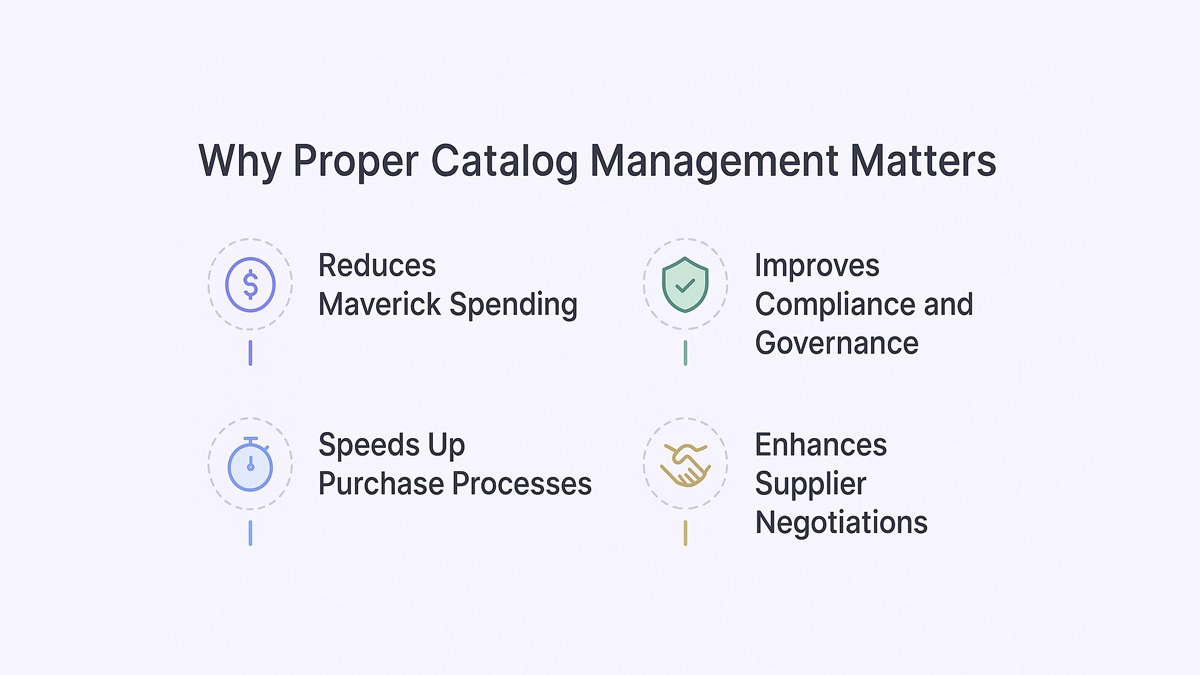

The Hidden Cost Saver: Why a Well-Managed Procurement Catalog Matters

The Hidden Cost Saver: Why a Well-Managed Procurement Catalog Matters
Explore how smarter procurement catalogs cut costs, improve compliance, and streamline purchasing workflows.


A poorly managed procurement catalog is like a messy storage room - everything you need is in there, but good luck finding it. Procurement teams often face invisible leaks in budgets due to outdated, scattered, or incomplete catalogs. These hidden inefficiencies quietly snowball into bigger problems, from maverick spending to compliance risks. The key to fixing this? A procurement catalog that’s not just managed - but optimized for clarity, control, and cost efficiency.
What this blog covers:
- What is a procurement catalog
- Why proper catalog management matters
- Types of procurement catalogs
- Key benefits of a well-managed catalog
- Common challenges in catalog management
- Best practices for maintaining an efficient catalog
- Leveraging technology for catalog optimization
- How Spendflo helps with procurement catalog management
- Frequently asked questions on procurement catalog
What is a Procurement Catalog?
A procurement catalog is a centralized digital listing of products and services that an organization is authorized to purchase from approved vendors. It includes item details, pricing, vendor information, and purchasing terms, allowing buyers to make informed, compliant purchases easily and quickly.
A well-maintained catalog helps teams buy smarter and faster - without going off-contract.
Why Proper Catalog Management Matters
An organized procurement catalog isn’t just about neat lists. It’s a frontline tool for reducing costs, improving efficiency, and increasing compliance across the purchasing process. When catalogs are accurate and up-to-date, procurement becomes less reactive and more strategic.

Here’s why proper catalog management truly matters:
Reduces Maverick Spending
When employees buy from outside approved suppliers or negotiated contracts, it leads to higher costs and compliance risks. A centralized catalog ensures employees stick to what’s been approved, keeping rogue spending in check.
Improves Compliance and Governance
Procurement teams face pressure to follow policy and regulatory guidelines. A well-managed procurement catalog enforces consistent buying behaviors - aligning purchases with contracts, budgets, and audit trails. It also helps reinforce adherence to internal purchasing policies.
Speeds Up Purchase Processes
Time wasted chasing approvals or verifying vendor info adds up fast. Catalogs streamline purchases by presenting pre-vetted items, saving valuable hours for both requesters and approvers.
Enhances Supplier Negotiations
When you consolidate and standardize purchases through cataloged vendors, you gain stronger negotiating power. Suppliers are more willing to offer better terms when they know they’re part of a high-volume, well-managed system. Catalogs also support sustainable procurement by favoring vendors that meet ethical and environmental standards. Procurement teams can use product benchmarking to evaluate vendor offerings and ensure competitive value.
Types of Procurement Catalogs
Procurement catalogs aren’t one-size-fits-all. Different formats serve different needs depending on the complexity of purchases, supplier relationships, and tech setup. Understanding the types of procurement catalogs helps organizations choose the right model - or even a mix - to meet their goals.
Here are the most common types of procurement catalogs:
Hosted Catalogs
These are static catalogs uploaded and maintained within the buyer’s procurement system. They’re easy to control and great for frequently purchased items, but they require manual updates to reflect changes in pricing or inventory.
Punchout Catalogs
With punchout catalogs, users access the supplier’s live e-commerce site directly from the procurement platform. Real-time pricing and availability are big perks here, but buyers lose some control over interface and content consistency.
Internal Catalogs
Built and managed entirely in-house, internal catalogs may list services, recurring purchases, or preferred items tailored to internal policies. These are helpful for non-standardized needs like IT services or facility management.
Third-Party Aggregated Catalogs
These catalogs are managed by external providers who consolidate offerings from multiple suppliers. They offer broad visibility and quick setup, especially for smaller teams, but may lack customization or deeper integrations.
Key Benefits of a Well-Managed Catalog
A procurement catalog isn’t just a tool - it’s a strategic asset. When managed well, it turns procurement from a reactive function into a proactive driver of cost savings, control, and efficiency.

Below are key benefits organizations gain from maintaining a well-managed procurement catalog:
Streamlined Procurement Workflows
With clear item listings and standardized processes, procurement teams spend less time on approvals, back-and-forth clarifications, and manual data entry. Consistent product listings play a vital role in maintaining catalog accuracy. Everything needed to place an order is ready at their fingertips.
Better Cost Control
Pricing errors and unauthorized purchases are two major cost drains. A clean, updated catalog helps prevent overpayment and ensures compliance with negotiated pricing across the board.
Improved Purchase Accuracy
No more guessing quantities, vendor SKUs, or pricing. Catalogs reduce human error by giving requesters the exact data they need - direct from the source. Effective product information management ensures this data is accurate and easy to retrieve.
Increased Buyer Satisfaction
A well-managed catalog gives employees the Amazon-like experience they expect - quick searches, clear descriptions, and easy ordering. When internal users trust the system, they’re more likely to follow it.
Common Challenges in Catalog Management
Even with the best intentions, managing procurement catalogs can feel like herding cats. With multiple vendors, dynamic pricing, and internal teams pulling in different directions, it’s easy for things to slip through the cracks. And when they do, inefficiencies pile up fast.
Here are some of the most common hurdles companies face:
Outdated or Inaccurate Data
Pricing, product specs, and availability change often - but catalogs don’t always keep up. Without regular updates, teams risk making decisions based on wrong or obsolete information, leading to delays or extra costs.
Poor Supplier Collaboration
Some vendors are slow to provide updates or unwilling to follow catalog formatting standards. This lack of alignment makes it harder to maintain clean, consistent catalogs that buyers can rely on.
Limited Catalog Adoption
Even a perfectly managed catalog is useless if employees don’t use it. Lack of awareness, poor UX, or insufficient training often leads teams to bypass official channels - resulting in maverick spend and missed savings.
Lack of Integration With Procurement Systems
When catalogs live outside core procurement tools, manual work creeps in. Disconnected systems make it harder to track purchases, enforce policies, or measure catalog performance.
Best Practices for Maintaining an Efficient Catalog
Avoiding catalog chaos isn’t about perfection - it’s about consistency, clarity, and a bit of strategic tech. With the right habits and tools in place, organizations can build catalogs that actually get used - and deliver measurable impact.
Here’s how to keep your procurement catalog running like a well-oiled machine:
Standardize Catalog Formats
Ensure suppliers follow a consistent format for item descriptions, pricing, and metadata. Clean product data entry at the source reduces downstream errors. This makes it easier to import, display, and maintain content across systems.
Regularly Audit and Update Content
Set a monthly or quarterly review schedule to check for outdated products, pricing errors, or discontinued SKUs. The goal is to make sure every item in the catalog is accurate, available, and aligned with contract terms.
Enable Real-Time Sync With Suppliers
Use APIs or punchout integrations to pull live updates from supplier systems. This reduces the burden of manual updates while keeping your catalog current and reliable.
Promote Internal Catalog Usage
Treat your catalog like a product. Make it easy to find, simple to navigate, and well-promoted. Applying search engine optimization principles can also improve catalog discoverability. Provide training, send reminders, and highlight time-saving features to boost internal adoption.
Leveraging Technology for Catalog Optimization
Procurement catalogs have come a long way from static spreadsheets tucked away in shared folders. Today, modern technology can turn a basic catalog into a dynamic, intelligent asset that continuously improves with use. The goal isn’t just digitization - it’s automation, insight, and smarter decision-making.
Smart procurement tools now use AI to recommend items based on past purchases, flag non-compliant entries, or even highlight better-value alternatives. Automated catalog updates ensure prices and availability stay current without relying on manual input. And when integrated with e-procurement platforms, catalogs can trigger workflows, approvals, and analytics with minimal friction. Automating workflows further reduces manual effort across the procurement process.
The result? A procurement engine that not only reduces effort but also enhances control, agility, and savings.
How Spendflo Helps with Procurement Catalog Management
Spendflo helps finance and procurement teams move from scattered spend to structured control - procurement catalogs included. Our platform consolidates supplier information, product details, and pricing into a centralized system that integrates with your existing tools.
By bringing automation into catalog updates and syncing with vendor systems, Spendflo reduces the manual effort needed to manage catalogs. Plus, our insights engine surfaces cost-saving opportunities, usage trends, and negotiation levers - so your team always knows where to optimize. Whether it’s enforcing compliance or improving catalog adoption, Spendflo makes procurement more streamlined and data-driven.
Frequently Asked Questions on Procurement Catalog
What are the types of procurement catalogs used by enterprises?
Enterprises typically use hosted catalogs, punchout catalogs, internal catalogs, or third-party aggregated catalogs. Each serves different needs based on the level of control, real-time data access, and supplier integration required.
How does a well-maintained catalog impact procurement ROI?
A well-maintained catalog ensures accurate pricing, reduces unauthorized spending, and speeds up the purchasing process - all of which contribute directly to cost savings and better procurement ROI.
What challenges arise when managing supplier catalogs?
Common issues include outdated item data, inconsistent formatting, limited collaboration from suppliers, and a lack of integration with procurement platforms, all of which can lead to inefficiencies and extra costs.
Can automation improve catalog accuracy and usage?
Yes, automation helps keep catalogs up-to-date by syncing with supplier systems, flagging inconsistencies, and simplifying user access - leading to better data accuracy and higher internal adoption.
How do procurement catalogs impact purchase orders and inventory management?
A well-managed procurement catalog streamlines purchase order creation by offering pre-approved items and pricing. This improves inventory management by aligning orders with actual inventory levels, ensuring just-in-time purchases and reducing overstock.
What role do catalogs play in supplier performance and cost control?
Catalogs integrated with a supplier portal allow for real-time supplier-managed catalogs and easier supplier evaluation. This supports better contract negotiation, strategic sourcing, and can help organizations unlock volume discounts.
Why should procurement teams track metrics like customer satisfaction and KPIs?
Tracking customer satisfaction and key performance indicators ensures that catalog performance aligns with business goals. From spend visibility to asset management, every stage of the procurement lifecycle benefits from transparent, data-driven decisions.










.png)




.png)










.avif)





